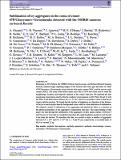Por favor, use este identificador para citar o enlazar a este item:
http://hdl.handle.net/10261/150373COMPARTIR / EXPORTAR:
 SHARE SHARE
 CORE
BASE CORE
BASE
|
|
| Visualizar otros formatos: MARC | Dublin Core | RDF | ORE | MODS | METS | DIDL | DATACITE | |

| Título: | Sublimation of icy aggregates in the coma of comet 67P/Churyumov-Gerasimenko detected with the OSIRIS cameras on board Rosetta |
Autor: | Gicquel, A.; Rodrigo Montero, Rafael CSIC ORCID; Gutiérrez, Pedro J. CSIC ORCID; Lara, Luisa María CSIC ORCID; López-Moreno, José Juan CSIC ORCID ; Tubiana, C. | Palabras clave: | Methods: numerical Methods: observational Methods: data analysis Comets: individual: 67P/Churyumov-Gerasimenko |
Fecha de publicación: | 2016 | Editor: | Oxford University Press | Citación: | Monthly Notices of the Royal Astronomical Society 462: S57- S66 (2016) | Resumen: | Beginning in 2014 March, the OSIRIS (Optical, Spectroscopic, and Infrared Remote Imaging System) cameras began capturing images of the nucleus and coma (gas and dust) of comet 67P/Churyumov¿Gerasimenko using both the wide angle camera (WAC) and the narrow angle camera (NAC). The many observations taken since July of 2014 have been used to study the morphology, location, and temporal variation of the comet's dust jets. We analysed the dust monitoring observations shortly after the southern vernal equinox on 2015 May 30 and 31 with the WAC at the heliocentric distance Rh = 1.53 AU, where it is possible to observe that the jet rotates with the nucleus. We found that the decline of brightness as a function of the distance of the jet is much steeper than the background coma, which is a first indication of sublimation. We adapted a model of sublimation of icy aggregates and studied the effect as a function of the physical properties of the aggregates (composition and size). The major finding of this paper was that through the sublimation of the aggregates of dirty grains (radius a between 5 and 50 ¿m) we were able to completely reproduce the radial brightness profile of a jet beyond 4 km from the nucleus. To reproduce the data, we needed to inject a number of aggregates between 8.5 × 1013 and 8.5 × 1010 for a = 5 and 50 ¿m, respectively, or an initial mass of H2O ice around 22 kg. © 2016 The Authors. | URI: | http://hdl.handle.net/10261/150373 | DOI: | 10.1093/mnras/stw2117 | Identificadores: | doi: 10.1093/mnras/stw2117 issn: 0035-8711 |
| Aparece en las colecciones: | (IAA) Artículos (CAB) Artículos |
Ficheros en este ítem:
| Fichero | Descripción | Tamaño | Formato | |
|---|---|---|---|---|
| IAA_2016_MNRASstw2117.pdf | 3,18 MB | Adobe PDF |  Visualizar/Abrir |
CORE Recommender
SCOPUSTM
Citations
23
checked on 22-mar-2024
WEB OF SCIENCETM
Citations
23
checked on 27-feb-2024
Page view(s)
236
checked on 22-abr-2024
Download(s)
227
checked on 22-abr-2024
Google ScholarTM
Check
Altmetric
Altmetric
NOTA: Los ítems de Digital.CSIC están protegidos por copyright, con todos los derechos reservados, a menos que se indique lo contrario.
